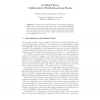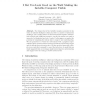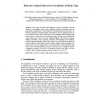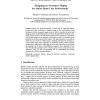92
Voted
AMI
2009
Springer
15 years 3 months ago
2009
Springer
Existing work on sensor-based activity recognition focuses mainly on single-user activities. However, in real life, activities are often performed by multiple users involving inter...
83
Voted
AMI
2009
Springer
15 years 4 months ago
2009
Springer
Abstract. We provide the first tool for verifying the logic of contextaware applications written for the mainstream sensor network operating system TinyOS; we focus on detecting pr...
111
click to vote
AMI
2009
Springer
15 years 7 months ago
2009
Springer
Abstract. We propose SAGE, an agent-based environment monitoring and control system based on computation logic. SAGE uses forward chaining deductive inference to map low level sens...
92
Voted
AMI
2009
Springer
15 years 7 months ago
2009
Springer
Abstract: Nowadays modern advertising environments try to provide more efficient ads by targeting costumers based on their interests. Various approaches exist today as to how infor...
88
Voted
AMI
2009
Springer
15 years 7 months ago
2009
Springer
In this paper we describe the use of collaborative filtering to make predictions about place using data from custom instant messaging status. Previous research has shown accurate ...
88
Voted
AMI
2009
Springer
15 years 7 months ago
2009
Springer
106
Voted
AMI
2009
Springer
15 years 7 months ago
2009
Springer
The design ideal of the invisible computer, prevalent in the vision of ambient intelligence (AmI), has led to a number of interaction challenges. The complex nature of AmI environm...
116
click to vote
AMI
2009
Springer
15 years 7 months ago
2009
Springer
This paper describes fall detection, activity recognition and the detection of anomalous gait in the Confidence project. The project aims to prolong the independence of the elderly...
108
Voted
AMI
2009
Springer
15 years 7 months ago
2009
Springer
Home care professionals play a central role in supporting elderly people when they need help to continue living in their own homes. Using awareness systems, caregivers might better...
100
Voted
AMI
2009
Springer
15 years 7 months ago
2009
Springer
Abstract. To better coordinate information displays with moving people and the environment, software must know the locations and three dimensional alignments of the display hardwar...




